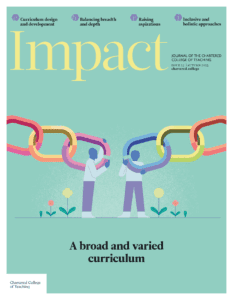Rethinking curriculum

EMILY RANKEN, ALICE BRADBURY, DOMINIC WYSE AND YANA MANYUKHINA
HELEN HAMLYN CENTRE FOR PEDAGOGY, UK
The project
The Rethinking Curriculum project (RC) aims to equip teachers and school leaders with the knowledge to plan and implement curriculum development in a way that will be sustained and impactful, with all pupils having access to an expansive, inspiring curriculum as a result. The programme is led by the Chartered College of Teaching in partnership with the Helen Hamlyn Centre for Pedagogy (HHCP); the role of the HHCP is to evaluate the project and support new ways of thinking about curriculum development. The project is funded by the Helen Hamlyn Trust.
The RC project grew out of the Open Futures programme (https://openfutures.com), previously funded by the Helen Hamlyn Trust between 2005 and 2017, which involved 80,000 pupils across 164 schools in England. Open Futures was an initiative that aimed to enhance education in primary schools through a unique, enquiry-based learning approach. Building on guidance from headteachers involved in Open Futures, the Chartered College of Teaching developed the Rethinking Curriculum project.
Through a Rapid Evidence Assessment (Ranken et al., 2024), the HHCP team identified existing research evidence that experiential learning is effective and should be a key element of an expansive and inspiring curriculum. The pilot phase of the RC project took place from September 2023 to July 2024, during which time six schools engaged in a personalised programme of support to aid them in curriculum development. This included collaborative co-design sessions, visits and coaching from a curriculum design lead, and curriculum experts being assigned according to schools’ interests, as well as funding to support teacher planning time out of class.
Schools were selected by the Chartered College’s Rethinking Curriculum project team, following the expression of interest process. Schools were located across England in both urban and rural contexts; they had previous OfstedThe Office for Standards in Education, Children’s Services and Skills – a non-ministerial department responsible for inspecting and regulating services that care for children and young people, and services providing education and skills judgments ranging from ‘requires improvement’ to ‘outstanding’; and they had large differences in pupil numbers and demographics. Researchers from the HHCP team conducted semi-structured interviews with 20 members of staff from across the six schools, plus the project’s curriculum design lead, at four points during the year, to evaluate schools’ progress and their perceptions as the project unfolded.
The main reason schools gave for their desire to develop their curriculum was to ensure that children’s learning at primary school was more closely aligned with their life experiences, needs and interests. Other reasons included addressing perceived shortcomings of the National Curriculum, preparing children for an uncertain future following the COVID-19 pandemic, and the opportunity for staff development.
Curriculum initiatives stemming from the project included: the implementation of oracy projects and child-led projects across the curriculum; increases in reflective practice and teacher confidence to adapt the curriculum; streamlining of the curriculum by removing excess content; and the implementation of different practices for assessing pupils’ learning. For several schools, the project allowed for the development of ideas that they had had for a while but had not been able to fully realise due to lack of time, resources or direction. Schools reported more involvement of teaching staff, support staff and children in curriculum development – something that is essential in order to achieve sustained curriculum change (Brundrett and Duncan, 2015). In addition to an increase in professional knowledge, several schools described an increase in staff enthusiasm and momentum to continue curriculum development.
Case studies
While all schools made significant progress in curriculum development through the pilot year, two examples are presented here to illustrate the impact of the project.
Cragside
Cragside Primary School is a large school in the suburbs of a city in the north-east of England. Staff at Cragside decided to use the RC project to help in achieving the aims of their existing school development plans – namely to ensure that a commitment to oracy and creativity was reflected in the curriculum. Their initial focus was to build these elements into science and the humanities. However, by the end of the year, the focus on oracy and creativity had ‘drifted into other curriculum areas naturally’ (Cragside deputy headteacher, July 2024).
By the end of the year, the focus on oracy had enabled lessons to become more child-led, with ‘children talking more in classrooms, listening to each other and learning through their talk’ (Cragside deputy headteacher, July 2024). It was described by one teacher as ‘liberating’, especially for younger children and those who were not yet accessing the formal curriculum. Teachers moved away from written work as the primary evidence of learning, and began to value children’s speaking more highly. The headteacher noted: ‘We’ve always been an inclusive school, but I think this work has allowed that inclusivity to really flourish because children aren’t hindered by things like [written] recording as much.’ (Cragside headteacher, July 2024)
Grayrigg
Grayrigg is a small rural school in the north of England. For the RC pilot year, staff planned to further increase representation and inclusionAn approach where a school aims to ensure that all children are educated together, with support for those who require it to access the full curriculum and contribute to and participate in all aspects of school life in the curriculum with regard to race, gender, ability and sexuality, to align with the school’s values of belonging and justice. In addition, they aimed to develop children’s research skills and self-directed learning, as well as their ability to critically assess information and present it to others. They wanted to maintain children’s independence, creativity and resilience, whilst ensuring progression through the curriculum.
One of Grayrigg’s main outcomes from the project was the development of a new project for each of the four classes in the school. For example, the Year 1/2 class project focused on an intergenerational aspect of justice and belonging. The curriculum design lead connected the school with a local community organisation that links schools and nurseries with care homes. Through this connection, staff developed ‘Grandfriends Day’, which now occurs once every half-term. On this day, every child has either a grandparent or a ‘grandfriend’ from the community visiting the school. Visitors play with the children and engage in conversations about the toys with which the children are playing, in comparison to those with which they used to play. This has supported children’s historical thinking in Key Stage 1, with the headteacher noting that learning ‘is much more real when it’s people that the children are connecting with’ (Grayrigg headteacher, March 2024).
Overcoming challenges
The pilot year was not without its challenges. Staff in all schools at some point expressed a ‘worry’ or even ‘fear’ that an Ofsted inspector would negatively judge the school on curriculum work that was new, not yet fully embedded or different from what Ofsted might be looking for. However, staff in five schools reported that the project had given them a sense of validation, with the backing of organisations such as the Chartered College of Teaching and University College London providing ‘gravitas’ to their work. For some schools, this was felt to be a protective factor against the fear of negative Ofsted inspections.
Rural schools reported that they felt their location could pose challenges to curriculum change, such as not being able to provide children with school trips due to the expense and difficulty of travel. However, despite this being considered a barrier at the beginning of the project, the two most rural schools described a newfound appreciation for their location by the end. Staff at one school noted that despite their initial desire to expand children’s understanding of ‘wider Britain’, by the end of the year they had altered their focus to ‘celebrate the changing face’ of their local area. This supports evidence suggesting that aligning curriculum change to schools’ unique contexts tends to be more successful (McLure and Aldridge, 2022).
The support provided by the project was key to overcoming challenges. The most impactful element of the project, according to all six schools, was the personalised support that they received from the Chartered College curriculum design lead and curriculum experts. The objectivity of the curriculum design lead allowed them to approach the work more ‘dispassionately’ (Flookburgh headteacher, July 2024) and from an ‘outside perspective’ (Coeli Regina teacher, March 2024). One school appreciated that their expert had been through the ‘same journey’ in terms of curriculum development and felt reassured by the fact that they were an ex-headteacher (Dorney, March 2024).
All schools felt that a supportive staff team that was open to professional challenge was essential. Research has shown that both effective use of staff time and resources and deliberate building of a supportive staff culture are key features of sustainable curriculum change (Koh et al., 2023). Schools that faced staffing difficulties across the pilot year reported that this significantly impacted their capacity for work on curriculum development. Consequently, a key focus for the curriculum design lead was supporting schools to build capacity, and providing funding for supply staff to cover teachers’ time out of class. A Reception teacher from Cragside described how, as a result of the project, ‘we’ve had time and training days, we get a lot of time in staff meetings to actually step back and redesign the curriculum’.
Looking to the future
All schools planned to continue the curriculum development work they had started during the pilot year. The deputy headteacher of one school described how the project had been a ‘kickstarter’, providing the skills needed to continue to ‘reassess and re-evaluate’ their curriculum. Other schools described the long-term plans they developed because of the project. Some examples of this included: a reassessment of school values to ensure alignment with the new curriculum; a three-year plan to build oracy-focused content into all areas of the curriculum; and collaboration with other schools on the project to learn more about community involvement in the curriculum.
Conclusion
The RC project provides important insights about the factors that can best support schools to implement meaningful and sustainable curriculum development. While the pilot schools all benefited from the project, an intensive programme with the levels of bespoke support that the pilot schools received may be unrealistic on a wider scale. Using the key aspects of the project to influence wider policy around curriculum was suggested by several schools as a means of ensuring that all schools would be able to engage in sustainable curriculum development. Ensuring that teachers and school leaders have the time, resources and licence to engage in meaningful curriculum development that is relevant to their unique context must be a priority, and we hope that the forthcoming Curriculum and Assessment Review will reflect this.
- Brundrett M and Duncan D (2015) Leading curriculum innovation in primary schools project: A final report. Education 3–13 43(6): 756–765.
- Koh GA, Askell-Williams H and Barr S (2023) Sustaining school improvement initiatives: Advice from educational leaders. School Effectiveness and School Improvement 34(3): 298–330.
- McLure FI and Aldridge JM (2022) A systematic literature review of barriers and supports: Initiating educational change at the system level. School Leadership & Management 42(4): 402–431.
- Ranken E, Wyse D, Manyukhina Y et al. (2024) The effect of experiential learning on academic achievement of children aged 4–14: A rapid evidence assessment. The Curriculum Journal 36(3): 417–434.










